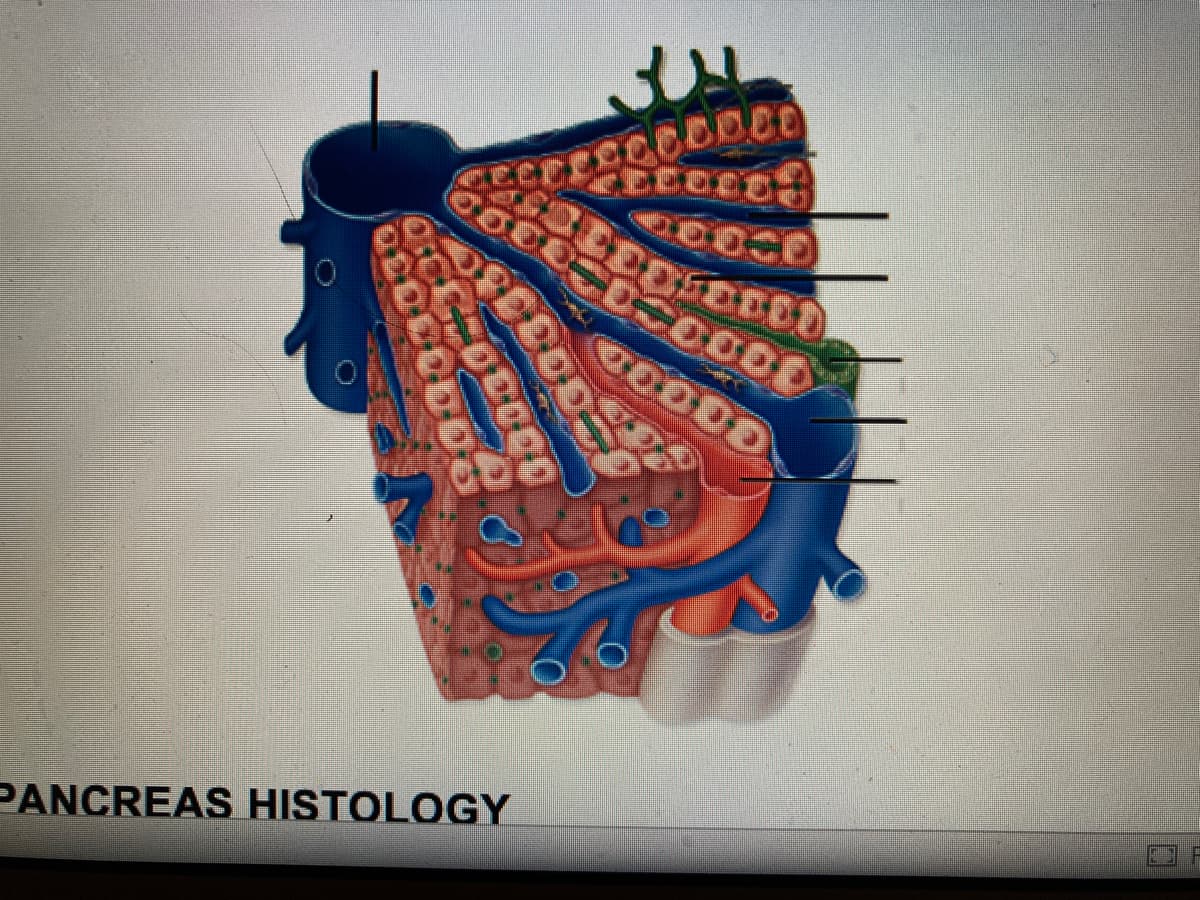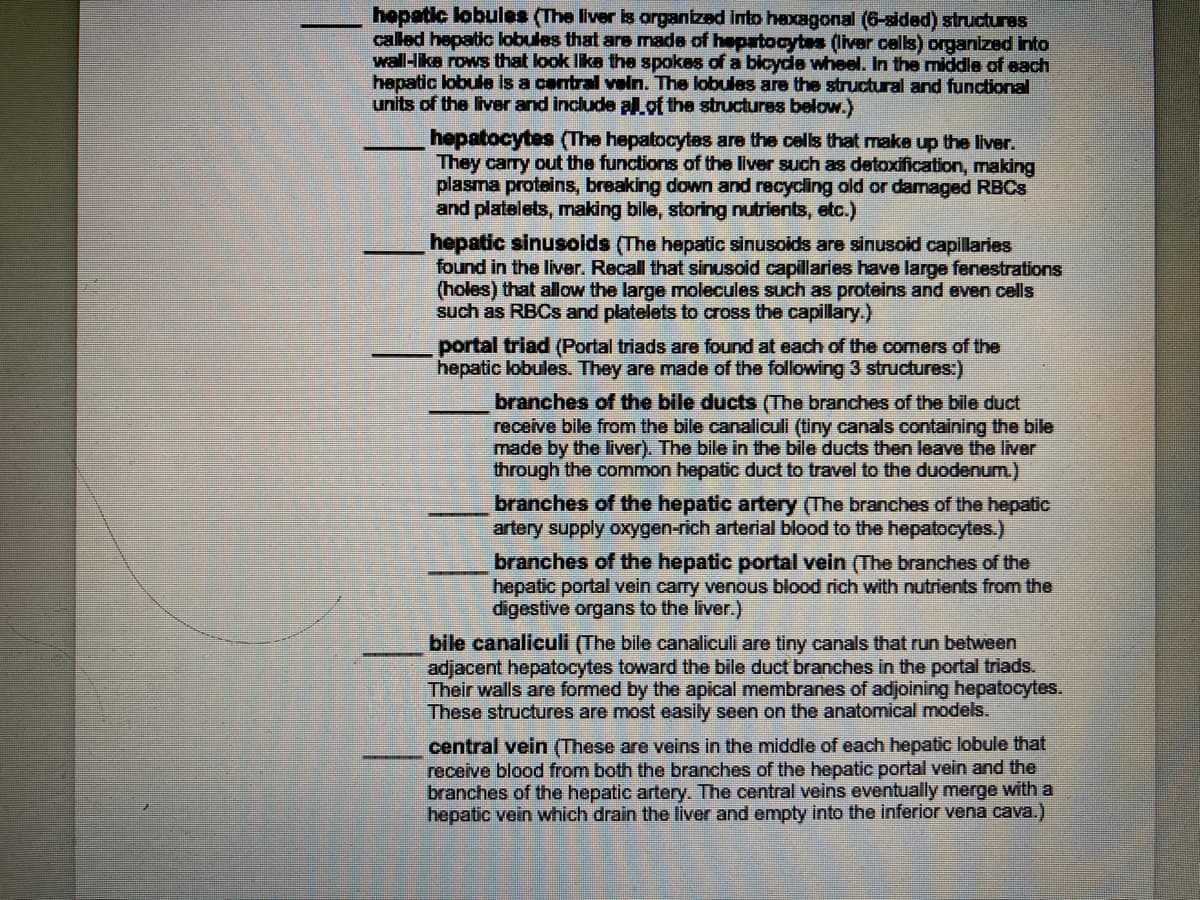seeresoCOD 00 FEECTES COOCO GEOCODOS OFF-00000 BROD=> SOLEDICEOD 100-D=0000 GOODD
seeresoCOD 00 FEECTES COOCO GEOCODOS OFF-00000 BROD=> SOLEDICEOD 100-D=0000 GOODD
Human Anatomy & Physiology (11th Edition)
11th Edition
ISBN:9780134580999
Author:Elaine N. Marieb, Katja N. Hoehn
Publisher:Elaine N. Marieb, Katja N. Hoehn
Chapter1: The Human Body: An Orientation
Section: Chapter Questions
Problem 1RQ: The correct sequence of levels forming the structural hierarchy is A. (a) organ, organ system,...
Related questions
Question
Label the image

Transcribed Image Text:REDFOD
COCO-D-600D
SOLFO DEED
500000
FLECTUS
RECEEELE
FORD
CCOO-
PANCREAS HISTOLOGY
POOCO
GOODD

Transcribed Image Text:hepatic lobules (The liver is organized into hexagonal (6-sided) structures
called hepatic lobules that are made of hepatocytes (liver cells) organized into
wall-like rows that look like the spokes of a bicycle wheel. In the middle of each
hepatic lobule is a central vein. The lobules are the structural and functional
units of the liver and include all of the structures below.)
hepatocytes (The hepatocytes are the cells that make up the liver.
They carry out the functions of the liver such as detoxification, making
plasma proteins, breaking down and recycling old or damaged RBCs
and platelets, making bile, storing nutrients, etc.)
hepatic sinusoids (The hepatic sinusoids are sinusoid capillaries
found in the liver. Recall that sinusoid capillaries have large fenestrations
(holes) that allow the large molecules such as proteins and even cells
such as RBCs and platelets to cross the capillary.)
portal triad (Portal triads are found at each of the corners of the
hepatic lobules. They are made of the following 3 structures:)
branches of the bile ducts (The branches of the bile duct
receive bile from the bile canaliculi (tiny canals containing the bile
made by the liver). The bile in the bile ducts then leave the liver
through the common hepatic duct to travel to the duodenum.)
branches of the hepatic artery (The branches of the hepatic
artery supply oxygen-rich arterial blood to the hepatocytes.)
branches of the hepatic portal vein (The branches of the
hepatic portal vein carry venous blood rich with nutrients from the
digestive organs to the liver.)
bile canaliculi (The bile canaliculi are tiny canals that run between
adjacent hepatocytes toward the bile duct branches in the portal triads.
Their walls are formed by the apical membranes of adjoining hepatocytes.
These structures are most easily seen on the anatomical models.
central vein (These are veins in the middle of each hepatic lobule that
receive blood from both the branches of the hepatic portal vein and the
branches of the hepatic artery. The central veins eventually merge with a
hepatic vein which drain the liver and empty into the inferior vena cava.)
Expert Solution
This question has been solved!
Explore an expertly crafted, step-by-step solution for a thorough understanding of key concepts.
Step by step
Solved in 3 steps with 1 images

Recommended textbooks for you

Human Anatomy & Physiology (11th Edition)
Anatomy and Physiology
ISBN:
9780134580999
Author:
Elaine N. Marieb, Katja N. Hoehn
Publisher:
PEARSON

Anatomy & Physiology
Anatomy and Physiology
ISBN:
9781259398629
Author:
McKinley, Michael P., O'loughlin, Valerie Dean, Bidle, Theresa Stouter
Publisher:
Mcgraw Hill Education,

Human Anatomy
Anatomy and Physiology
ISBN:
9780135168059
Author:
Marieb, Elaine Nicpon, Brady, Patricia, Mallatt, Jon
Publisher:
Pearson Education, Inc.,

Human Anatomy & Physiology (11th Edition)
Anatomy and Physiology
ISBN:
9780134580999
Author:
Elaine N. Marieb, Katja N. Hoehn
Publisher:
PEARSON

Anatomy & Physiology
Anatomy and Physiology
ISBN:
9781259398629
Author:
McKinley, Michael P., O'loughlin, Valerie Dean, Bidle, Theresa Stouter
Publisher:
Mcgraw Hill Education,

Human Anatomy
Anatomy and Physiology
ISBN:
9780135168059
Author:
Marieb, Elaine Nicpon, Brady, Patricia, Mallatt, Jon
Publisher:
Pearson Education, Inc.,

Anatomy & Physiology: An Integrative Approach
Anatomy and Physiology
ISBN:
9780078024283
Author:
Michael McKinley Dr., Valerie O'Loughlin, Theresa Bidle
Publisher:
McGraw-Hill Education

Human Anatomy & Physiology (Marieb, Human Anatomy…
Anatomy and Physiology
ISBN:
9780321927040
Author:
Elaine N. Marieb, Katja Hoehn
Publisher:
PEARSON